Placer miner Mike Heisey is open to all options when it comes to his two claims in Dawson City’s Dredge Pond subdivision, he said in an interview this week.
Heisey recently applied to renew his permit to work the two claims that straddle the Klondike River.
His original plan was to work on them this spring to determine whether or not they were worth mining, Heisey told the News on Thursday.
But he said he “could consider” negotiating compensation for the claims to avoid the community kerfuffle.
“As a possible compromise, and if it would help keep the peace within Dawson and the subdivision, I might consider selling these mining claims back to the government, or be granted a deed to the two claims in exchange for giving up the mining rights,” Heisey said.
The two claims were staked in 1980. Heisey bought them in 2002.
The closest residential lot to the claims is 20 metres away. The claim on the north side of the Klondike River is zoned hinterland. The claim on the south side is zoned country residential.
The area is recognized as important wildlife habitat, a tourism route and a salmon-spawning ground. The Klondike River is also a source of drinking water for some residents.
But when Heisey bought the claims in 2002, he had no problem securing the land use permit and water licence he is now hoping to renew.
“When I purchased the claims, it sailed through all the regulatory comment period and everything without one single comment by one individual or agency,” said Heisey. “And now, 10 years later, the whole world is completely different. Yet nothing has changed with respect to those claims, my mining plan or anything. This is a simple renewal.”
But that was before the Yukon Environmental and Socio-economic Assessment Act was passed in 2003.
Heisey admits he could keep his claims active by paying $200 annually for each, but he said he wants the option to eventually work them.
“What good is it to have a claim if you don’t have the licensing and permits for it, I mean to keep it active so I can use it and work with it if I ever want to?” he said.
“I never said never, I just said not right now.”
Heisey said his claims aren’t that close to homes and if any mining were to take place, the noise generated would be no worse then regular construction noise. The Callison Industrial Park across the road produces “almost constant machine noise,” he said.
Concerns about his plan to ford the river between the two claims are unfounded, he said. Any problems with spawning fish and water quality could be mitigated, he added.
Although he looked at options other than fording the river, they were more costly and possibly more detrimental, he said.
The Yukon Environmental and Socio-economic Assessment Board is no longer taking public comments on Heisey’s application.
It received almost 30 submissions. They came from the town, the First Nation, federal departments, tourism operators, the Klondike Visitors Association, the Dawson District Renewable Resource Council and a number of Dawson residents.
“The whole world is up in arms,” said Heisey. “This is an unfortunate predicament for the family farm of the North. I have a big mining enterprise. I’m one of the largest miners in the Yukon and I personally pumped over $1 million worth of revenue into the city of Dawson in jobs for a number of employees, well over a dozen, and consultants and so forth this past year. And so I have to ask, why are people so against mining?”
His company, Heisey Ventures Inc., also has claims in the Indian River area and he sits on the board of the Klondike Placer Miners’ Association.
Heisey said he is sympathetic to the concerns expressed during the YESAB process.
“Every effort would be made to conduct any mining operation in a manner that is sensitive to and minimizes those concerns,” he said.
“It does seem like the best solution at this point would be to have the government buy me out or trade the mining rights for fee simple title to the land. The Slinky Mine and my claim-licence renewal, both within city limits, have brought an issue - conflict to the surface that apparently needs to be resolved, as there are other mining claims within the city limits and the public appears to be less tolerant today than in the past with regard to mining.
“I’ve been a very stable and dependable seasonal resident of that subdivision and I like my neighbours. I don’t want anybody to be up in arms and I’m not trying to create any fights or wars or anything. But mining claims predate the creation of the subdivision and people presumably knew there were mining claims in the area before they purchased their lots. At least, that information was available in the public records.
“People should remember that mining is what created Dawson and even today it is one of the largest contributors to the lowcal economy. Without mining, who would be left in Dawson City?”
Contact Roxanne Stasyszyn at
roxannes@yukon-news.com
